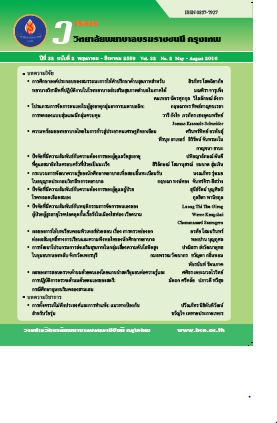A METABOLIC SYNDROME SELF-MANAGEMENT PROGRAM FOR OLDER ADULTS: A RANDOMIZAED CONTROLLED TRIAL โปรแกรมการจัดการตนเองในผู้สูงอายุกลุ่มอาการเมตาบอลิก: การทดลองแบบสุ่มและมีกลุ่มควบคุม
คำสำคัญ:
metabolic syndrome, self-management program, randomized controlled trials, older adults, lifestyle behaviors, physiological indicators.บทคัดย่อ
บทคัดย่อ
การศึกษาครั้งนี้มีวัตถุประสงค์เพื่อประเมินผลของโปรแกรมการจัดการตนเองในกลุ่มอาการเมตาบอลิกต่อ พฤติกรรมการดำเนินชีวิตและตัวชี้วัดทางฟิสิโอโลจิคอลในผู้สูงอายุกลุ่มอาการเมตาบอลิก กลุ่มตัวอย่างที่ผ่านเกณฑ์การคัดเลือกทั้งหมด 66 คน สุ่มเข้ากลุ่มทดลองและกลุ่มควบคุม กลุ่มละ 33 คน กลุ่มทดลองได้รับโปรแกรมการจัดการตนเองในกลุ่มอาการเมตาบอลิกและการพยาบาลตามปกติขณะที่กลุ่มควบคุมได้รับการพยาบาลตามปกติเพียงอย่างเดียว โปรแกรมฯ ประกอบกิจกรรม 4 ขั้นตอนใช้ระยะเวลา 6 สัปดาห์ โดยมุ่งเน้นไปที่พฤติกรรมการรับประทานอาหาร การทำกิจกรรมทางกายและการออกกำลังกาย เก็บข้อมูลก่อนการทดลอง หลังการทดลอง (สัปดาห์ที่ 6) และระยะติดตามผล (สัปดาห์ที่ 12) โดยใช้แบบสัมภาษณ์พฤติกรรมการรับประทานอาหารและ ประเมินการมีกิจกรรมทางกาย และการออกกำลังกายของผู้สูงอายุ และประเมินตัวชี้วัดทางฟิสิโอโลจิคอล ประกอบด้วย ระดับกลูโคสในเลือด ระดับไตรกลีเซอร์ไรด์ ระดับเอชดีแอล ค่าเส้นรอบเอว และ ระดับความดันโลหิต วิเคราะห์ข้อมูลโดยใช้สถิติพรรณนา สถิติ ที ไคว์สแคว์ และ การวิเคราะห์ความแปรปรวนพหุคูณ แบบวัดซ้ำ
ผลการศึกษาพบว่าคะแนนพฤติกรรมการดำเนินชีวิตและตัวชี้วัดทางฟิสิโอโลจิคอลในผู้สูงอายุกลุ่มอาการเมตาบอลิกที่ได้รับโปรแกรม MSSM ดีขึ้นกว่ากลุ่มควบคุมอย่างมีนัยสำคัญทางสถิติ (Pillai’s Trace =.407, F(8, 57) = 4.88, p < .001) และ คะแนนพฤติกรรมการดำเนินชีวิตและตัวชี้วัดทางฟิสิโอโลจิคอลมีปฏิสัมพันธ์ระหว่างกลุ่มกับเวลาอย่างมีนัยสำคัญทางสถิติ (Pillai’s Trace = .693, F(16, 49) = 6.92, p < .001) นอกจากนี้ผู้สูงอายุกลุ่มอาการเมตาบอลิกที่ได้รับโปรแกรม MSSM มีคะแนนเฉลี่ยของพฤติกรรมการดำเนินชีวิตและตัวชี้วัดทางฟิสิโอโลจิคอลเมื่อเปรียบเทียบระหว่างก่อนการทดลองหลังการทดลองและระยะติดตามผลพบว่าค่าเฉลี่ยแตกต่างกันอย่างมีนัยสำคัญในช่วงสามเวลาอย่างน้อยหนึ่งคู่ (Pillai’s Trace = .723, F(16, 49) = 8.01, p < .001).
ผลการศึกษาพบว่ากลุ่มทดลองมีการปรับเปลี่ยนในทางที่ดีขึ้นของพฤติกรรมการรับประทานอาหารและ การมีกิจกรรมทางกายและการออกกำลังกายและตัวชี้วัดทางฟิสิโอโลจิคอลประกอบด้วยระดับน้ำตาลและไตรกลีเซอไรด์เมื่อเปรียบเทียบระหว่างหลังการทดลองและระยะติดตามผล ส่วนเส้นรอบเอวลดลงเฉพาะหลังการทดลอง แต่อย่างไรก็ตาม โปรแกรม MSSM ไม่มีผลต่อการปรับเปลี่ยนระดับ เอชดีแอล และระดับความดันโลหิตให้ดีขึ้น
Abstract
This study aimed to evaluate the effects of a specific Metabolic Syndrome Self-Management (MSSM) program on lifestyle behaviors and physiological indicators in older adults with metabolic syndrome. Sixty-six participants who met the inclusion criteria were randomly assigned to either the experimental (n=33) or control (n=33) group. The experimental group received the MSSM program based on self-management with usual care, while the control group received usual care only. The 6-week program focused on eating behavior and physical activity, and included four phases. Data were collected at pre-test, post-test (6th week), and follow-up (12th week). Eating behaviors were assessed using the Eating Behavior Questionnaire, while physical activity was assessed using The Rapid Assessment of Physical Activity. Physiological indicators included fasting plasma glucose, triglycerides, high-density lipoprotein, waist circumference, and blood pressure. Data were analyzed using descriptive statistics, independent t-tests, chi-square tests, and repeated measures MANOVA. The results showed that the scores of lifestyle behaviors and physiological indicators in older adults with metabolic syndrome (MetS) were significantly better for those receiving the MSSM program than the control (Pillai’s Trace = .407, F(8, 57) = 4.88, p < .001). There were significantly better of mean scores of lifestyle behaviors and physiological indicators on interaction of group and time (Pillai’s Trace = .693, F(16,49) = 6.92, p < .001). In addition, older adults with MetS who received the MSSM program (experimental group) had different mean scores of lifestyle behaviors and physiological indicators when compare between pre-test, post-test, and follow-up. The mean scores differed significantly across the three time periods in at least one pair (Pillai’s Trace = .723, F(16,49) = 8.01, p < .001). Results revealed that the experimental group had significantly greater improvements on eating behaviors, physical activity and physiological indicators including fasting plasma glucose and triglycerides at post-test and follow-up, and had significant improvement on waist circumference only at post-test. However, this program could not significantly improve high-density lipoprotein and blood pressure.
Downloads
ดาวน์โหลด
เผยแพร่แล้ว
รูปแบบการอ้างอิง
ฉบับ
ประเภทบทความ
สัญญาอนุญาต
บทความที่ได้รับการตีพิมพ์ เป็นลิขสิทธิ์ของวารสารวิจัยสุขภาพและการพยาบาล (วิทยาลัยพยาบาลบรมราชชนนี กรุงเทพ) ไม่สามารถนำไปตีพิมพ์ซ้ำในวารสารฉบับอื่น


















